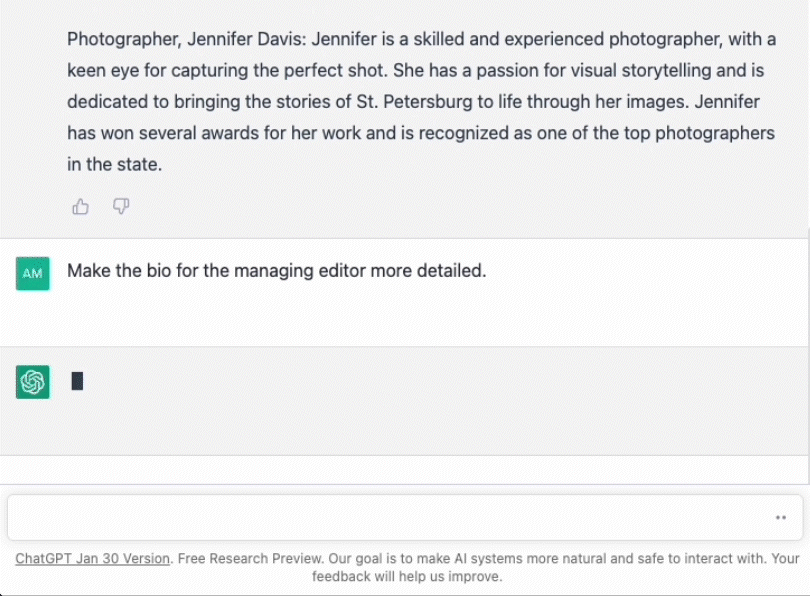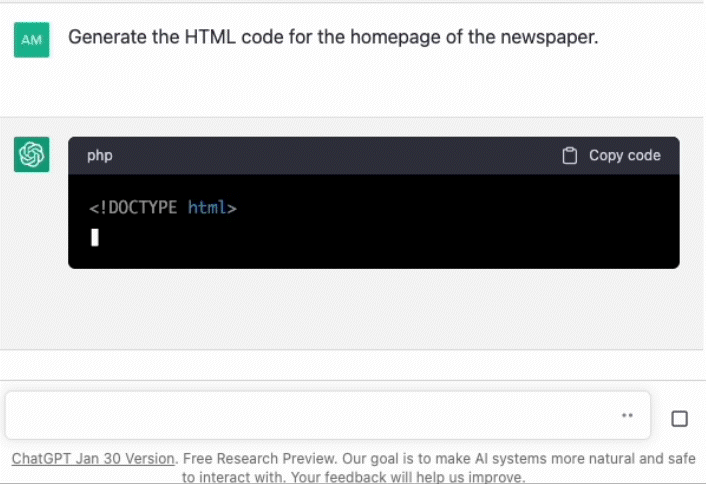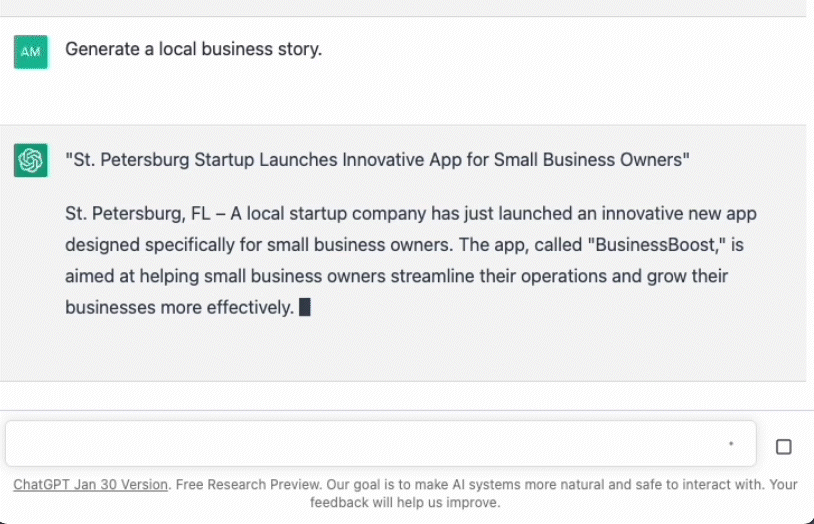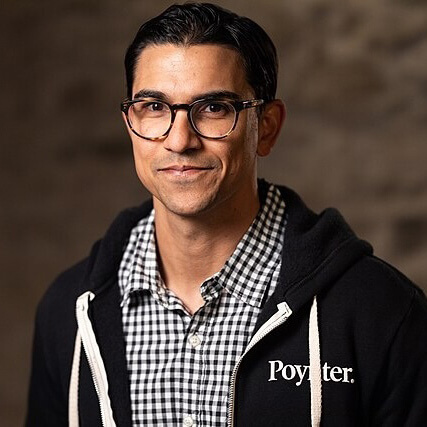Michael Martinez, managing editor of the Suncoast Sentinel, is a foodie who loves jazz, volunteers at local homeless shelters and spends his days hiking in Florida’s state parks.
One problem: Neither Martinez, nor the Suncoast Sentinel, exist.
In less than a half hour, and with just a few sentences of input, the buzzy AI text-generator ChatGPT spit out details about Martinez — that he’s worked in journalism for 15 years and “has a reputation for being a strong leader and excellent mentor” — and a masthead of reporters, editors and a photographer for the nonexistent Suncoast Sentinel.

ChatGPT generates a bio for Michael Martinez, the totally made-up managing editor of the totally made-up Suncoast Sentinel. (Alex Mahadevan/Poynter)
“Okay I am freaked out,” tweeted former White House official Tim Wu — who coined the term net neutrality in 2003 — when I posted my first attempt at made-up newspapers with ChatGPT.
I’m always skeptical about tech freak-outs. But, in just a few hours, anyone with minimal coding ability and an ax to grind could launch networks of false local news sites — with plausible-but-fake news items, staff and editorial policies — using ChatGPT.
Here’s how it works, from my colleague Seth Smalley:
The technology works by sifting through the internet, accessing vast quantities of information, processing it, and using artificial intelligence to generate new content from user prompts. Users can ask it to produce almost any kind of text-based content.
Political operatives, lobbyists and ad dollar-chasing grifters have launched dubious news sites — referred to as “pink slime” — in relatively short order without using a tool like ChatGPT. Some hired contractors in the Philippines to produce stories, while others used algorithms — the foundation of AI — to generate hundreds of articles based on government databases, said Priyanjana Bengani, senior research fellow at the Tow Center at Columbia Journalism School, who studies pink slime networks.
“Are the barriers to entry getting lower? The answer is yes,” Bengani said. “Now anybody sitting anywhere can spin one of these things up.”

AI-generated “headshots” of “reporters” for the Suncoast Sentinel. (Alex Mahadevan/Poynter)
In about two minutes, while juggling other tasks, I used thispersondoesnotexist.com — another AI tool — to generate headshots for Martinez, editor-in-chief Sarah Johnson, copy editor Sarah Nguyen, photographer Jennifer Davis, and others.
“Shining a light on St. Petersburg” was ChatGPT’s first crack at a slogan for the Suncoast Sentinel. It spit out “Uncovering the stories that matter in St. Petersburg” when I asked for something a little more exciting.
It wrote me editorial and corrections policies, a couple letters to the editor, and totally fabricated articles about a new local art gallery and BusinessBoost, a fake app developed by fake St. Petersburg entrepreneurs.
It generated an article accusing local officials of rigging the election. And an article alleging the mayor ran a no-bid scheme in one of the biggest redevelopment projects in the area’s history.
I even asked ChatGPT to generate the HTML code for the homepage of the burgeoning fake newspaper and it complied. And it gave me a starting point for more complex Javascript code to make the fake site “sexy and interactive.”

ChatGPT generates HTML for the made-up Suncoast Sentinel website. (Alex Mahadevan/Poynter)
Its results weren’t flawless. It got the name of the mayor wrong twice (there have been a few elections since Rick Baker was in office, bot). And, as you can see with Martinez’ bio, ChatGPT generates ridiculously boring copy.
“I dont think it’s going to be transformative overnight,” said Bengani, noting that the media (yes, me included) also freaked out about deepfakes two years ago and DALL-E last year. We’ve yet to see impactful disinformation campaigns materialize from either — the highly publicized deepfake of Ukrainian President Volodymyr Zelenskyy was quickly debunked.
The model doesn’t update in real time, and can’t provide specific details that the locals who would be affected by an issue would look for in a story (for example, ChatGPT wouldn’t provide the size or cost of the redevelopment project I used in my experiment).
Going back to the false business story I created, you can see the cracks in ChatGPT that would make an editor cringe — or tear their hair out. Here’s a paragraph from the “story”:
The founders of the company, brothers Tom and Jerry Lee, were inspired to create the app after seeing the struggles of small business owners in the St. Petersburg area. They saw a need for an affordable and accessible solution that would help these business owners compete in today’s fast-paced business environment.
“Small business owners are the backbone of our local economy,” said Tom Lee. “We wanted to create a tool that would help them succeed, and that’s exactly what BusinessBoost does.”

ChatGPT generates a business article for the made-up Suncoast Sentinel website. (Alex Mahadevan/Poynter)
It reads like a student skimmed the pages of The Wall Street Journal for business buzzwords and regurgitated them out with a couple of fake names and a hilariously ill-conceived business. But that is kind of how ChatGPT works, right?
To defend against ChatGPT’s potential use as a tool for misinformation, among other malicious uses, OpenAI has already launched a “classifer” to identify AI-generated text. I laughed out loud when I plugged in some chunks of this experiment and received:
“The classifier considers the text to be possibly AI-generated.”
OK.
Still, as director of Poynter’s digital media literacy initiative MediaWise, I know that most people judge a “news” website based on how legitimate it looks, including its bylines and web design.
That may have been at least a semi-reliable measure in the past, but with ChatGPT, for example, it’s simple to launch a false news site that satisfies all of those “signals.”
“Previously a well written, well laid out publication with headshots and bylines, etc., meant something,” said Mike Caulfield, a research scientist at the University of Washington’s Center for an Informed Public who teaches media literacy tactics, in a Twitter message. “It didn’t always mean it was reputable, but there was at least a partial correlation between something looking that way and being known, or ‘real’ — even if ‘real’ and wrong. Signals of authority were expensive, and that formed a barrier to entry.”
In many schools across the U.S., teachers use outdated methods in identifying sketchy websites, said Caulfield, who has an upcoming book with Stanford History Education Group founder Sam Wineburg that includes a chapter on this issue. These methods are mostly useless when it comes to AI-generated, plausible false news organizations.
“What has happened over the past 30 years is that the formerly expensive signals — the ones that focused on surface features — have become incredibly cheap,” he said. “But we are still teaching students to look for those signals. It’s a massive disaster in the making.”
Lateral reading, one of the foundational media literacy techniques developed by SHEG and taught by MediaWise, encourages users to leave a website and use a search engine to find out more about the news outlet or other organization instead of relying on the website’s “about us” page or masthead, for example.
Bengani suggests copying and pasting text from a potential pink slime website into Google to look for plagiarism — a major red flag in identifying these networks.
OpenAI didn’t respond to a request for comment, but when I asked ChatGPT about how AI like itself could impact the information ecosystem, it replied:
Generated content can easily spread misinformation, especially if it is not thoroughly fact-checked or if it is generated with biased or inaccurate data. Additionally, the ease with which AI can generate large volumes of content can make it difficult for users to determine the credibility of a source. This can make it easier for false or misleading information to spread, potentially undermining public trust in journalism and information as a whole.
It’s important for AI models like me to be used responsibly and in accordance with ethical guidelines, such as providing balanced and fair reporting and protecting the privacy and dignity of sources and subjects. Additionally, it’s important for news organizations to fact-check and verify all information before publishing it, whether it was generated by AI or not.
ChatGPT’s complicated relationship with journalism doesn’t end with quick-scaling false news websites. Trusted news sites have already fumbled with AI and produced misinformed copy. CNET was recently caught doing it, and BuzzFeed said it will start using ChatGPT-based technology to generate “new forms of content.”
“I think the problem is that it’s not just what the pink slime guys are doing,” Bengani said.







